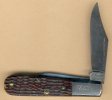- Joined
- Nov 26, 2009
- Messages
- 3,020
With Boardwalk Empire making its return tonight I was wondering what pocket knife options these fine gentleman would have the option to carry in their time?
The BladeForums.com 2024 Traditional Knife is ready to order! See this thread for details:
https://www.bladeforums.com/threads/bladeforums-2024-traditional-knife.2003187/
Price is $300 $250 ea (shipped within CONUS). If you live outside the US, I will contact you after your order for extra shipping charges.
Order here: https://www.bladeforums.com/help/2024-traditional/ - Order as many as you like, we have plenty.
A couple of the most popular high end "gentlemen's" patterns were the three and four blade Orange Blossom patterns - in pearl especially (these were some of the most expensive production patterns of the day -- the Remington Bullets cost a lot less).

As noted, these are mostly knives for the middle class or above. Any sense of what an urban workman would have carriied back then?
My thanks.

Check out the factory file work ion the four blade - they were listed in the 1908 catalog for $36/doz., the whittler for $15.75/doz. Them were the days.
